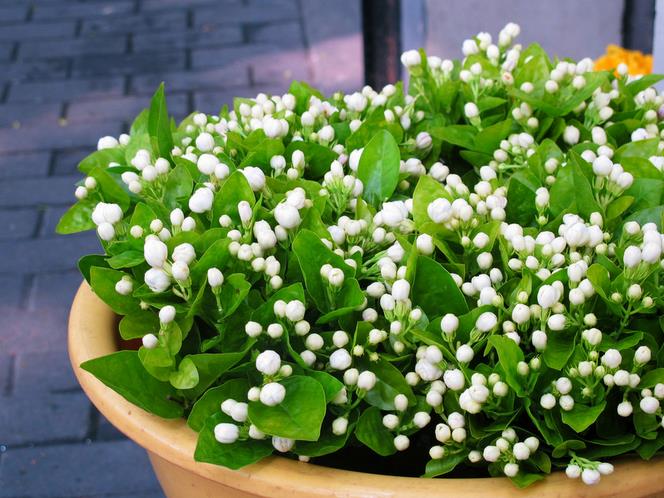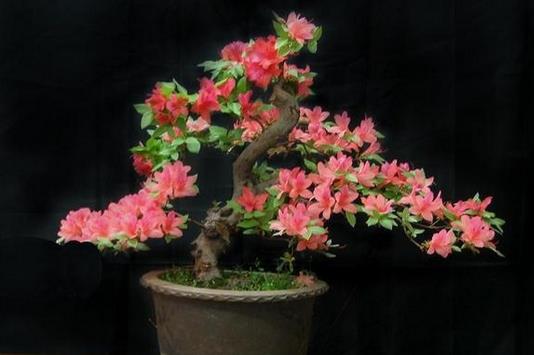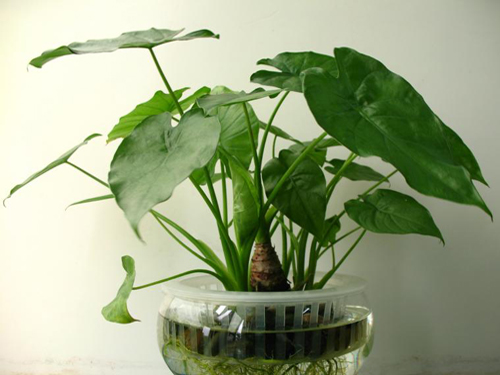What are the growth habits of jasmine? What is the culture method of jasmine?
What is the growth habit of Jasmine?
Jasmine likes warm and humid nature, grows best in a well-ventilated and semi-shady environment, blooms most and smells most when it is hot and humid in summer and has strong light. If the light is insufficient, the leaves are large and the flowers are small. The soil with a lot of humus slightly acidic sandy loam for the most suitable. Most varieties like warm climate, fear cold, fear drought, not resistant to frost, wet and alkaline earth, winter temperature is lower than-3℃, branches and leaves easily suffer from freezing damage, such as long duration will die, growth temperature 25-33℃, growth period to have sufficient moisture and humid climate, air humidity in 80%-90%, like fertilizer, ph5.5-7.0. And deciduous vines are very cold and drought tolerant.
Jasmine flowers like warm, moist and sunny environments. Jasmine is sensitive to temperature, can adapt to high temperature, low temperature tolerance, poor cold resistance. When the temperature is 0℃, the tender parts of leaves and branches wither lightly, and most branches wither and die seriously. The optimum temperature for jasmine growth is 25~35℃. It grows very slowly below 10 ° C and even stops growing. It can sprout at around 19℃. It grows slowly below 25℃ and breeds buds above 25℃. 30~40℃ was the best temperature for bud formation and development, and 32~37℃ was the optimum temperature for bud maturation and opening. More than 37℃ flowers can open, but often occurs stuffy yellow phenomenon, poor aroma.
Jasmine is a light-loving long-day plant. Under the direct light irradiation, the most suitable jasmine growth and development. Such as insufficient light or shade, jasmine leaves become large and thin, light green leaves, poor growth and development. The stronger the illumination, the more developed the root system, the stronger the plant growth and the stronger the resistance.
The wind has certain influence on the growth and development of jasmine. In summer, the southeast wind is more southeasterly, with a lot of water vapor, which makes the air humidity increase and jasmine grows vigorously. West wind or northwest wind to promote air humidity and temperature drop, bud development is inhibited, flowers are often insufficient, some flowers turn purple. In hot summer, the north wind blows jasmine, which promotes white and fragrant flowers; the south wind or easterly wind blows, evaporation is large, which will cause water loss and leaf loss, affecting growth.
For soil requirements, loose, fertile sandy loam, 6~6.5 out of the most appropriate. Potting soil can be used garden soil and chaff ash or garden soil and vermiculite, rotten leaf soil mixed soil.

What is the growth habit of Jasmine? What is the cultivation method of jasmine?
2. What is the cultivation method of jasmine?
1. Cultivation Techniques of Jasmine
Summer: full summer every day early and late watering, such as dry air, need to supplement water spray.
Winter: winter dormancy period, to control the amount of watering, such as pot soil too wet, will cause rotten roots or leaves. During the growth period, thin cake fertilizer should be applied once a week.
Spring: spring for pots, to often pick the heart plastic, flowering, to cut again, in order to germinate new branches, so that plants neat and robust, blooming exuberant.
1. Jasmine cultivation soil conditions
The soil for potted jasmine cultivation needs to be rich in organic matter, and it must also have certain ventilation and water permeability. The soil can be made from four parts of compost, four parts of pastoral soil, two parts of rice bran ash or two parts of river sand, and in addition, cooked and rotten dried cake powder and chicken and duck feces are added to make, and some coarse particles and powders are screened and spread in the basin.
2. Fertilization for Jasmine Culture
Jasmine likes big water and fertilizer in flowering period. Jasmine flowering period is from June to September. During flowering period, it is necessary to fertilize frequently, preferably liquid fertilizer containing more phosphorus, such as fishy water fertilizer solution or decomposed bean cake, or calcium superphosphate and ammonium sulfate, etc., which need to be fertilized once every two to three days. Liquid fertilizer rich in nitrogen, phosphorus and potassium can be applied once a week. If it can be used alternately with alum fertilizer water, the effect will be better. This can not only make the plant nutrition balance, leaves green and plump, flowers big flower fragrance, but also can effectively prevent the occurrence of plant chlorosis. When the chemical fertilizer composition is too much, it may burn the jasmine plant. At this time, we can spray some potassium dihydrogen solution containing 0.1% phosphoric acid to jasmine leaves in the evening, which can promote jasmine to bloom more.
3. Jasmine's water requirements
Jasmine likes wet environment, in its flowering period, watering is more important. Because summer temperature is higher, plant transpiration is larger, it should be given sufficient water, early and late should be watered once, morning and afternoon should also be given to plant leaves and pots around a spray of water, in order to enhance the humidity of the air. However, it should be noted that on cloudy days and rainy days, less or no watering should be done. On rainy days, attention should also be paid to avoiding rain and preventing ponding in the basin.
4. Trimming of Jasmine Culture
Jasmine is a new branch flowering, so in its flowering period should strengthen pruning, especially pay attention to picking, flowering branches should also be cut short in time to promote multiple branches, multiple pregnant buds. Jasmine flowers most vigorously with 3-6 year old seedlings, and then senescence year by year, so it must be re-cut and renewed in time. Before the Spring Festival sprouting, the branches of last year can be appropriately cut short, retaining the base 10 - 15 cm, so that most of the sturdy new branches occur, such as the new branches grow very vigorously, they should be picked when they grow up to 10 cm, and the second shoots should be promoted, and the flowers are more, and the wipe type is compact and the ornamental value is high.
Note: pruning should be carried out in sunny days, combined with thinning leaves, removing diseased branches, and adjusting plants to facilitate growth and flowering.
5. Jasmine cultivation sunshine
Jasmine likes light, likes hot, humid, ventilated and breathable environment, and needs sufficient light. Jasmine insufficient light easy to make the plant branches slender, yellow leaves, but too strong light, but also appropriate shade, otherwise easy to make the leaves by sunlight burns. Jasmine can be placed in semi-shade and exposed only to light before 9 a.m. and after 5 p.m. Jasmine is afraid of cold. Potted jasmine in the south can be cultivated outdoors for wintering. In the north, warm work should be done in autumn and winter. Move indoors and put it in the south direction. Light is strong branches, leaves green, flowers and fragrance, lack of sunlight is sparse flowers and less fragrance.
What is the growth habit of Jasmine? What is the cultivation method of jasmine?
What is the shape and growth habits of jasmine flowers, and what you need to know about planting
Jasmine flowers are loved by people. Flower language means respect, purity, simplicity, delicacy and charm. However, how much do you know about jasmine, what are its forms and growth habits, and what are its values and functions. The next chapter will tell you about Jasmine.
growth habit
Leaves, opposite, simple, papery, rounded, elliptic, ovate-elliptic or obovate, 4 - 12.5 cm long, 2 - 7.5 cm wide, rounded or obtuse at both ends, sometimes slightly cordate at base, lateral veins 4 - 6 pairs, slightly concave or concave above, convex below, veinlets often obvious on both surfaces, slightly convex, glabrous except for tufted hairs between axils of lower veins; petiole 2 - 6 mm long, pubescent, articulated.
Flowers, terminal, usually 3 flowers, sometimes single or up to 5; peduncle 1 - 4.5 cm long, pubescent; bracts minute, conical, 4 - 8 mm long; pedicel 0.3 - 2 cm long; flowers very aromatic; calyx glabrous or sparsely pubescent, lobes linear, 5 - 7 mm long; corolla white, corolla tube 0.7 - 1.5 cm long, lobes oblong to subrounded, 5 - 9 mm wide, apex rounded or obtuse. Fruit globose, ca. 1 cm in diam., purple-black. The flowering period is from May to August and the fruiting period is from July to September.
efficacy
Jasmine flower has the function of qi opening. Jasmine flower contains volatile oily substances, with qi analgesic, Jieyu Sanjie role, can alleviate abdominal pain, diarrhea in the acute and heavy symptoms, for pain therapy Jiapin. Jasmine is cold, fragrant, flatulence elimination, pungent, sweet, warm, jasmine has the effect of regulating qi and relieving pain, warming stomach, detumescence and detoxification, strengthening immune system, and has good anti-inflammatory and detoxification effects on dysentery, abdominal pain, conjunctivitis and sore poison. Jasmine aroma can calm mood, jasmine effect can also be in addition to bad breath, endocrine regulation, moisturizing skin color, menstrual disorders have a considerable effect. Aroma can enhance the ability of the body to cope with complex environments, eliminate mental fatigue, mood tension and so on.
precautions
Jasmine breeding process should pay special attention to its fertilization, generally from May, every 7 days to apply light bean cake water, in the bud and flowering period to do thin fertilizer frequently, about every 5 days to apply once. Fertilization stops in October. Every rainy season in outdoor cultivation, instead of applying dry fertilizer, such as with bean cake powder (pot surface loose soil, add bean cake powder, covered with soil). Apply 0.2% ferrous sulfate water every 10 days during the growing season to keep the soil acidic. Jasmine water regulation is the key to cultivation: jasmine likes wet, afraid of ponding, pot soil too wet easy to rot roots and leaves and even death. Jasmine flowers only grow branches and do not bloom generally because of excessive nitrogen application or lack of sunlight. Therefore, when jasmine enters the vigorous growth period, it should strictly control the amount of nitrogen fertilizer applied, and more sun exposure to avoid excessive plant growth.
The above is what I introduced to you about jasmine related aspects, I hope to help you, please continue to pay attention to the fleshy flower beds, for more information.
How do jasmine flowers grow? Jasmine flower florescence maintenance method
Photo: Jasmine
[Common Question]: Jasmine flowers are raised like this?
[Expert Answer]: To raise jasmine flowers, first of all, let's take a look at the growth habits of jasmine flowers. Jasmine flowers like warm and humid nature and grow best in a well-ventilated, semi-shady environment. The soil with a lot of humus slightly acidic sandy soil for the most suitable. Most varieties are afraid of cold, drought, frost, waterlogging and alkaline earth, so know the growth habits of jasmine, how should we plant jasmine?
[Breeding Environment]:
1, light: Jasmine likes hot, humid, ventilated environment, need sufficient light. Jasmine is afraid of cold. Potted jasmine in the south can be cultivated outdoors for wintering. In the north, warm work should be done in autumn and winter. Move indoors and put it in the south direction. Light is strong branches, leaves green, flowers and fragrance, lack of sunlight is sparse flowers and less fragrance.
2. Moisture: Jasmine is not drought-tolerant, but it is forbidden to accumulate water. In rainy seasons, it is necessary to dump accumulated water in the basin in time, otherwise the leaves are easy to yellow. Summer hot sunny days to water twice a day, morning and evening once, such as found that the leaves should be sprayed on the leaves, promote growth.
3, soil: cultivation jasmine soil to fertile sandy and semi-sandy soil is good, in the pH value of 6 to 6.5 slightly acidic soil planting, then the roots dense, vigorous growth, such as heavy soil viscosity, lack of matrix, fertility is low, poor ventilation, then the roots are less, the plant is short, the stems and leaves are slender, the flowers are few and small.
Photo: Jasmine
[Citi Conservation]: Jasmine is very fond of fertilizer. As long as it is properly maintained, potted jasmine can bloom three times a year. If the fertilizer is insufficient, nutrient is not enough, after a flower, no longer flowering. If management is in place, it can be kept from the end of May to the beginning of November. The key is pruning, sunlight, and fertilizer control.
Jasmine flowers from early summer, if properly managed, can appear three full flowers.
In early June, jasmine flowers bloom early one after another. The method of flower picking is to pick off the leafy shoots to promote the new branches to grow again and the branches and leaves are lush. At this time, apply light fertilizer water twice a week and keep the basin soil moist.
From late June to early July is the first full bloom, at this time, it is necessary to strengthen fertilizer and water management, thin fertilizer and frequent application, fertilization once every two days, fully decomposed organic liquid fertilizer, fertilizer and water ratio of 1:4. Water should be sufficient, usually once a day. Watering is usually best done in the morning, while fertilizing is best done in the evening. This continues until late July, due to sufficient fertilizer and water, can make flowers bloom larger and more.
In early August, the second phase of flower formation, fertilization at this time should be slightly thicker than before, generally half of fertilizer and water is appropriate. In order to promote jasmine better flowering, but also to spray superphosphate solution to the leaves. In late August, gradually reduce fertilization, 6~7 days apply once, watering still need more, keep 2 days once.
From early September to early October, the third stage of flower formation, at this time should stop fertilization, watering amount should also be gradually reduced, because the weather has gradually turned cool, will affect the formation of flower buds, so the number of flowers is less, to mid-October after the flowering end, just keep the pot soil slightly wet can be.
[Summary]: First, that is jasmine flowering maintenance and related amount of knowledge, want to raise jasmine in addition to the maintenance of the mind, must be clear jasmine growth habits oh, so that management will be easier.
- Prev

Production and cultivation of Yingshanhong bonsai
With the development of globalization, people more and more know how to enjoy life and satisfy the spiritual world through a variety of leisure activities. Nowadays, people often plant bonsai, pruning, watering and fertilizing every day. There are many kinds of cultivation, and there are simple potted plants
- Next

How to raise Guanyin in dripping water? What do you need to pay attention to in the breeding of Dishui Guanyin?
Many friends will put a pot of dripping Guanyin at home to do indoor green plant decoration. after we buy Dishui Guanyin home, we must consider the breeding method and matters needing attention of Dishui Guanyin. Today, the editor collates and summarizes the problems often encountered in the breeding process of Dishui Guanyin.
Related
- Fuxing push coffee new agricultural production and marketing class: lack of small-scale processing plants
- Jujube rice field leisure farm deep ploughing Yilan for five years to create a space for organic food and play
- Nongyu Farm-A trial of organic papaya for brave women with advanced technology
- Four points for attention in the prevention and control of diseases and insect pests of edible fungi
- How to add nutrient solution to Edible Fungi
- Is there any good way to control edible fungus mites?
- Open Inoculation Technology of Edible Fungi
- Is there any clever way to use fertilizer for edible fungus in winter?
- What agents are used to kill the pathogens of edible fungi in the mushroom shed?
- Rapid drying of Edible Fungi

